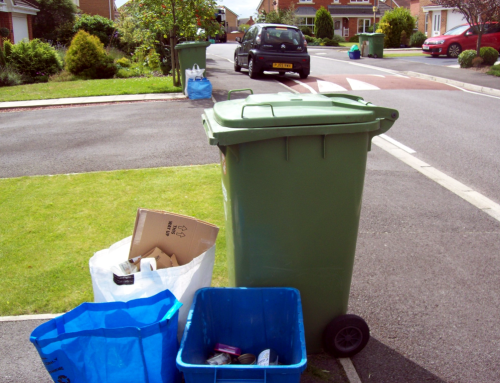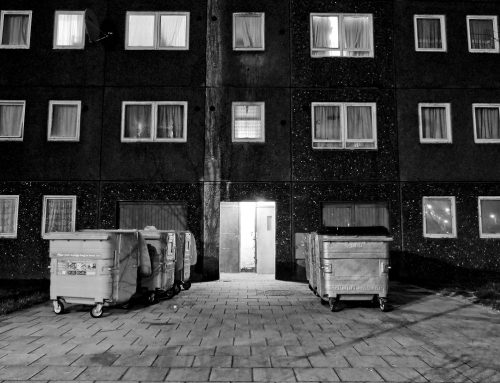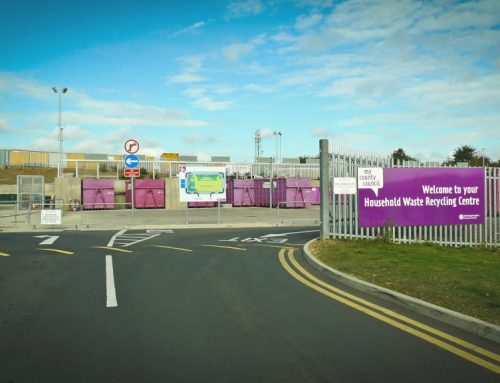by Steve Watson
7 minute read
For a relative newcomer to our streets and homes, the wheeled bin has come to occupy an important place in both British civic and cultural life. They have helped change how waste is managed, and – whether as the subject of the Daily Mail‘s ire or being ridden down a dale by the cast of Last of the Summer Wine – media appearances have been frequent.
Almost all councils now provide them: those who don’t are in a very small and reducing minority. Places where concerns about the visual impact of wheelie bins have delayed their introduction continue to succumb to their charms: Bath and North East Somerset was the latest to roll them out – and not without some local controversy. It seems that the dominance of the wheelie bin is almost complete.
But it wasn’t always this way. It may be hard to imagine now, but waste management prior to the early 1980s used to involve a rather different interaction between householder, bin, and waste collector. So, take a ride with us in Isonomia’s wheelie bin time machine, as we roll back the decades and lift the lid on the past.
Paladin sane
Domestic waste was first put on wheels as early as the 1930s. By then, large, cylindrical, wheeled refuse containers called Paladins were being used as communal bins in properties such as flats – as well as in commercial settings. Manufactured in Wigan by a manufacturer called Pagefield, they were designed for use with their commercial waste vehicles – indeed, the name ‘Paladin’ seems to have originally referred to the whole, patented collection system and only later to have become attached to the containers.
These bins allowed waste to be stored more efficiently and were easier for operatives to move than a fleet of small, standard dustbins. They were also able to be mechanically lifted – so they certainly helped save the back of many a worker. This was a technological advance born of the necessity of collecting large volumes of waste, and represented a considerable step, both in terms of waste management and health and safety.
However, it was many years before the wheeled bin was reinvented for use in normal kerbside collections of household waste; the reasons for this are illustrative of the history of waste in general. The household bin first gained popularity in the early 20th century, in response to the type of waste they needed to hold. Prior to that date, households produced little waste – and most of it consisted of ashes from the burning of whatever leftovers couldn’t be made use of. This would be tipped into an ashpit privy at the bottom of the garden for collection.
As open coal fires begin to be replaced by new energy sources, it signalled the death of this system – even before the waste households produced began to change its composition. Faced with a stream of waste that wasn’t just ashes, householders began to fashion their own metal waste containers out of tins and the like. In turn, these changes created a collection and disposal challenge for municipalities.

Bin henge: the wheelie bin has not been with us since ancient times, but is now woven into the fabric of everyday life. Photo: Michael Billington (CC BY-SA 3.0), via Wikimedia Commons.
As the 20th century progressed, changing patterns of production and consumption led to households producing more waste – especially packaging. Household bins gradually increased in size to keep up. Medium sized metal bins – typically of around 90 litres’ capacity – were common in the 1950s; while in the 1960s, the age of plastics was taking off and hot ashes were less common – so larger plastic bins appeared, capable of holding larger volumes of packaging (itself increasingly made of plastic).
You wheelie got me
By this time, the portability issues that had led to the invention of the paladin were emerging at the household level. In those days, householders weren’t generally required to present their bin at the kerbside rather, the bin man would come onto the property to collect it. Bigger bins therefore weighed heavy on collection crews; and in the 1960s and 70s it looked like single-use plastic refuse sacks might be the answer, offering a lightweight, disposable alternative to the bin. However, the wheel turned once again, and the wheeled bin was soon to come rolling over the horizon. It was safer, as there was less risk of operatives cutting themselves on broken glass or other sharp items that might protrude from a sack; and more secure from rats, seagulls and anything else that might have an interest in the contents of your rubbish.
The origins of the modern household wheelie bin appear to be a little convoluted. Many sources date its invention to 1968, and a now defunct plastics company in Slough, Frank Rotherham Mouldings, where wheelie bins were used to move waste around the factory. Others, though, say they were developed in Germany in 1970s. It was not until the early 1980s that the now-familiar design of the household wheelie bin first found its way onto our streets. When and where, however, is shrouded in some mystery.
My research turned up a Defra document available online, which states that Broxtowe Borough Council was the first to introduced wheeled bins for refuse collection, dating this pioneering move to 1983. However, I am told there is another Government report (titled ‘A research study on the effects of the introduction of continental style wheeled containers on the generation and collection of household waste in Bury MBC’), which some believe proves Bury to be the true claimant of the title of wheelie bin-novator. Sadly, after a good deal of searching I’ve been unable to find a copy. If readers can shed any light on which council really led the way, I’d love to hear from them.
Whoever did it first, the switch to wheeled bins gained pace because they solved a real problem. Lugging around big, heavy bins that were no longer fit for purpose, given the amount of waste coming out of people’s homes, couldn’t continue. Partly this was a health and safety issue, but was also time-consuming and inefficient.
As some councils looked to privatise waste collections, a process accelerated by compulsory competitive tendering, there was a shake-up of historical waste collection practices. Costs became more visible, and compelled changes to increase productivity and reduce expenditure. Wheelie bins allowed a change in the part residents were expected to play in the collection operation: no longer would the bin man pick up and return your bin from your back yard or doorstep; now it was safe to require householders to wheel them out to a convenient location on the kerbside for collection. Collecting each bin took less time, and each vehicle needed fewer crew.
Getting wheel
Once households were producing so much waste each week that they needed to put it on wheels just to safely move it about, it was a clear sign that we’d developed a problem. The wheelie bin made waste collection quicker and safer, but initially it just contained the problem, rather than doing anything to reverse the upward trend in waste production. In fact, the first 240L wheelie bins were considered so massive they were affectionately termed ‘waste guzzlers’; and simply made it easier for householders to chuck away as much as they liked. Reports from the mid-80s suggested a 50% increase in waste generation from affluent areas, some of it attributable to people starting to bin things they never had before, such as garden waste.
This was in the hey-day of cheap landfill, though. While waste disposal authorities may not have been thrilled with the logistical challenged posed by so much additional waste, disposing of it was a fairly simple, low cost undertaking. With the arrival of the landfill tax – especially the tax escalator – and recycling targets, things would change once again. Some councils provided separate wheeled bins for garden waste, and as MRF technology developed, some households would also receive a wheeled by for dry recycling. Where once there had been one wheelie bin, by 2010 some households had three, and the term “bin blight” entered the lexicon.
And so we arrive at the present day. There aren’t many 240 litre residual waste bins still rolling about. Councils have reduced the size of the bins they provide, and the frequency with which they are collected, as they try to encourage householders to recycle.
The wheelie bin continues to change its role as the waste management environment in which it finds itself. Given the ubiquity of wheeled bins on today’s streets, it looks like the wheel will keep turning for some time yet; what revolutions might tomorrow hold?






For an update, bin manufacturer SSI Schaefer have been in touch to let us know that they were the first company to introduce wheeled bins to the UK. What’s more, Broxtowe was indeed the first council to receive wheeled bins (both 240 litre and 120 litre), many of which are still on the streets today. However, only one month later Newtonards Council (now Ards and North Down BC) also received a delivery of wheelies from Schaefer, again many of which are still with us. Thanks to Schaefer for helping to shed more light on the origins of the wheelie bin.
Lots of different versions of history!
In Finding out about Managing Waste,http://www.incpen.org/docs/FOAMW2005.pdf weekly dustbin waste is:
1936
weight 17kg; density 290kg/cu m
1963
weight 14kg; density 200kg/cu m
2000
weight 17kg; density 140kg/cu m
Interesting article. I introduced wheeled bins to my former authority in 2002 (as part of an AWC pilot) and then wider. The service had tried to introduce them in 1988 but was roundly condemned by the members!
Several observations from my roll out – some people were really (really) anti them! Others couldn’t believe we didn’t use them. I suspect if you tried to remove them from the previously anti brigade they’d have your legs off now.
Secondly – people really didn’t know how to use them. They’d claim the bin was full then you’d find empty uncrushed boxes in them (we didn’t collect cardboard for recycling initially). It was a revelation to them that you could crush a box.
Finally, we had a councillor who refused a bin for several years and took his rubbish to the HWRC as he hated them that much. He than passed away and within a week his wife rang asking for a bin as it turned out it wasn’t him who had to take the rubbish to the tip…but her.